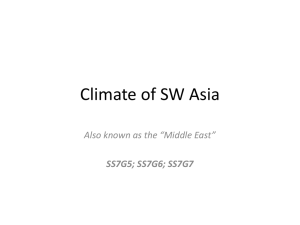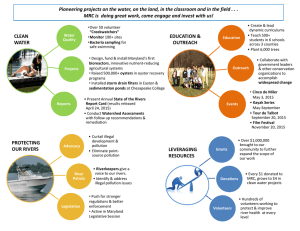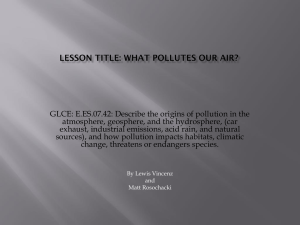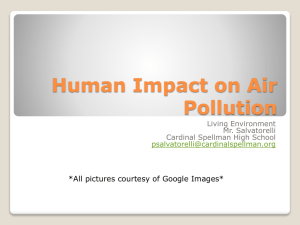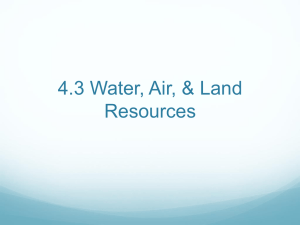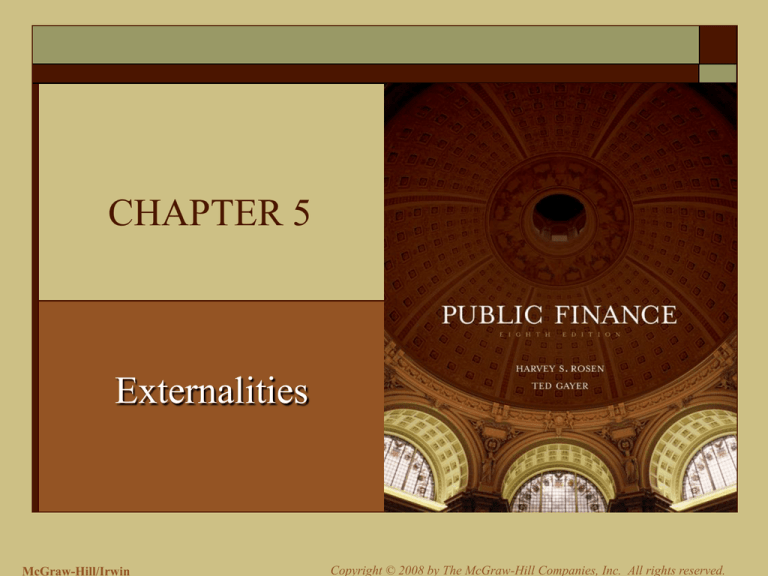
CHAPTER 5
Externalities
McGraw-Hill/Irwin
Copyright © 2008 by The McGraw-Hill Companies, Inc. All rights reserved.
Externalities
Externality
An activity on one entity that affects the welfare
of another entity in a way that is outside the
market mechanism
Increase in Social Costs
Pricing Effects
Suburban to Urban Migration
Rent on Condos Increase
Externality?
5-2
The Nature of Externalities
Privately vs. Public Ownership
Bart Operates a Polluting Factory on a Stream
Lisa Fishes on the Stream
Who owns the stream?
Does Bart have the right to operate a polluting factory
on the stream?
5-3
The Nature of Externalities
Can Consumers Produce Externalities?
5-4
The Nature of Externalities
Examples of Positive Externalities?
5-5
What Pollutants Do Harm?
Empirical Evidence: What is the Effect of Air
Pollution on Health?
How would you conduct a study?
5-6
What Pollutants Do Harm?
What Activities Produce Pollutants?
What is the Value of the Damage Done?
How Much?
Buy and Sell Pollution?
Empirical Evidence: The Effect of Air
Pollution on Housing Values
5-7
Implications for Income Distribution
Who Benefits?
Poor are Disproportionately Affected by Air
Pollution
Who Bears the Cost?
5-8
The Nature of Externalities-Graphical Analysis
Factory Pollutes Stream
Perfect Price Discriminator
Fisherman with Sick Fish
Marginal Damage or Social Cost
5-9
The Nature of Externalities-Graphical Analysis
$
MPC
Marginal
Private Cost
MB
0
Q1
Marginal
Benefit
Q per year
Actual output
5-10
The Nature of Externalities-Graphical Analysis
Suppose we have the following example:
MD= 25Q
MPC=50+40Q
Demand: P=400-5Q
Find Quantity of Widgets in Equilibrium
Find Social Efficient Quantity of Widgets
MSC
Find Gain to Society
Calculate Loss to Factory and Gain to Fisher
5-11
Pollution Reductions
We see postive effects of reducing negative
externalities such as pollution.
How do we get there?
Private Options
Public Options
5-12
The Coase Theorem
Coase Theorem
Provided that transaction costs are negligible, an efficient
solution to an externality problem is achieved as long as
someone is assigned property rights, independent of who
is assigned those rights
5-13
Bargaining and the Coase Theorem
MSC = MPC + MD
$
MPC
h
d
g
c
MD
MB
0
Q*
Q1
Q per year
5-14
The Coase Theorem
Coase Theorem
Provided that transaction costs are negligible, an efficient
solution to an externality problem is achieved as long as
someone is assigned property rights, independent of who
is assigned those rights
Assumptions:
Low Bargaining Costs
Ability to Identify the Source of Damage
US Air Pollution?
5-15
Other Private Solutions
Mergers
Social Conventions
Socially Acceptable
5-16
Public Response to Externalities
Taxes and Subsidies
Mandatory Pollution Reductions
Command and Control
Emissions Fees
Cap and Trade
5-17
Public Responses to Externalities – Taxes
MSC = MPC + MD
(MPC + cd)
$
MPC
d
MD
MB
0
Q*
Q1
Q per year
5-18
Public Responses to Externalities – Taxes
Calculate Tax Revenue
Calculate Producer Surplus
Calculate Producer’s Loss
Calculate Gain to Outside Firm
5-19
Pigouvian Tax Revenue
What should be done with this tax revenue?
5-20
Public Responses to Externalities - Subsidies
MSC = MPC + MD
$
MPC
d
c
MD
MB
0
Q*
Q1
Q per year
5-21
Public Responses to Externalities – Taxes
Calculate Subsidy
Calculate Producer Surplus
Calculate Producer’s Loss
Calculate Gain to Outside Firm
5-22
Pollution Reductions
We see postive effects of reducing pollution.
How do we get there?
Public Options
Private Options
5-23
Uniform Pollution Reductions
Consider Two Firms (B and H)
Each Starts Out Pollution 90 Units
Marginal Cost of Reducing Pollution
MCB = 2/3P
MCH = 2P
You Want to Reduce Pollution by 100 Units
Consider Uniform Pollution Reductions
Each Firm Reduces 50 Units
What would each firm pay to reduce these units?
5-24
Uniform Pollution Reductions
MCH
MCB
50
90
Bart’s
pollution
reduction
50
90 Homer’s
pollution
reduction
5-25
Command-and-Control Regulation
Incentive-based regulations
Command-and-Control Regulations
5-26
Command-and-Control Regulation
Technology Standard
Performance Standard
Costs
7% to 22 Times More Expensive (ERP 2003)
Corporate Average Fuel Economy (CAFE)
27.5 MPG Cars 20.7 MPG Light Trucks
Gas Tax
$700 Billion More for Raising CAFE (CBO
2004c)
5-27
The U.S. Response
Clean Air Act
1970 Amendments
Environmental Protection Agency (EPA)
Command-and-Control
All 6 Air Pollutants Fell
Causation?
Contrary Studies
Air Pollution on Decline Before 1970
Air Pollution Lower Due to EPA
5-28
Emissions Fee
$
MC
MSB
0
e*
Pollution reduction
5-29
Uniform Pollution Reductions
MCH
MCB
f=
$50
f=
$50
50
75
90
Bart’s
pollution
reduction
25
50
75
90 Homer’s
pollution
reduction
5-30
Uniform Pollution Reductions
Fair?
5-31
Uniform Pollution Reductions
Cost Effective
MC(P1)=MC(P2)
Suppose not. MC(P1)≠MC(P2)
Without Loss of Generality
Suppose: MC(P1)>MC(P2)
Cost of reducing firm 1’s last unit of pollution was
more expensive than firm 2’s.
There is a smaller cost to society if firm 2 reduces
one more unit and firm 1 reduces one less unit.
5-32
Cap-and-Trade
Goal: Decrease Pollution by 100 Units
80 Permits Issued
Suppose Bart Gets All 80
5-33
Cap-and-Trade
Bart’s Responsibility?
Homer’s?
5-34
Cap-and-Trade
MCH
MCB
10
50
75
90
Bart’s
pollution
reduction
25
50
75
90 Homer’s
pollution
reduction
5-35
Cap-and-Trade
Homer’s Cost?
Willingness to Pay for 1 Permit?
Willingness to Pay for 2 Permits?
For how many will he trade?
What would he be willing to pay?
What is Bart willing to accept?
5-36
Progress with Incentive-based Approaches
Policy Perspective: Cap-and-Trade for Sulfur
Dioxide
Policy Perspective: Cap-and-Trade to Protect
Fisheries and Wildlife
individual transferable quotas
5-37
Emissions Fee v Cap-and-Trade
Inflation
Emissions or Cap-and-Trade
Cost Changes
Emissions or Cap-and-Trade
5-38
Cap-and-Trade
MCH
b
MCB
$100
$100
$50
$50
a
10
50
75
90
Bart’s
pollution
reduction
25
50
75
90 Homer’s
pollution
reduction
5-39
Cap-and-Trade v Emissions Fee
MC’
$
MC*
f*
MSB
0
ef
Too little pollution reduction
e’ e*
Too much pollution reduction
Pollution reduction
5-40
Cap-and-Trade v Emissions Fee
MC’
$
MC*
f*
MSB
0
ef
Too little pollution reduction
e’
e*
Too much pollution reduction
Pollution reduction
5-41
Cap-and-Trade v Emissions Fee
Consider Lower Marginal Costs for an
Inelastic and Elastic MSB Line with a Partner
What Underperforms?
What Overperforms?
5 Minutes
5-42
Distributional Effects
Revenue?
Emissions fee
Cap-and-Trade
5-43
Positive Externalities
$
MC
MSB = MPB + MEB
MPB
MEB
R1
R*
Research
per year
5-44
Positive Externalities
Requests for subsidies
Resource extracted from taxpayers
Market does not always fail
Policy Perspective: Owner-Occupied Housing
5-45



